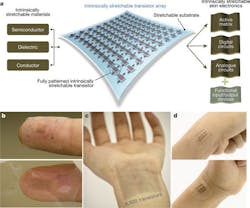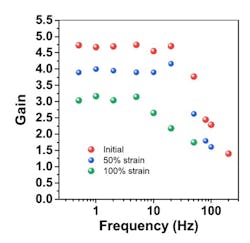The Human Touch: Stretchable Electronic Skin Can "Feel"
The flexibility and sensitivity of a human hand’s skin is one of the many factors that uniquely distinguishes it from even a highly functional robotic gripper, regardless of its human-like articulation and dexterity. Any comparable sensing material must cover a wide area, and be flexible, stretchable, and waterproof—a very difficult set of somewhat conflicting objectives. A viable artificial version would be beneficial as a skin-like covering for prosthetics, as well as for developing flexible electronic products with unique form factor, functionality, and packaging.
Now there’s progress toward skin-like material with sensing capability. After over two decades of focused effort, a large, multidisciplinary team based at Stanford University, led by chemical engineer Zhenan Bao, has developed a “skin” using an array of thousands of transistors—and recently demonstrated its flexibility and ruggedness.
Their paper “Skin electronics from scalable fabrication of an intrinsically stretchable transistor array” published in Nature, plus the detailed Supplementary Information packet, provides details on the concept, design, fabrication, and performance. (The project is supported by Samsung Electronics, the National Science Foundation Graduate Research Fellowship Program, and NETEP and MOTIE of the Republic of Korea.)
1. Shown are key aspects of the use of the intrinsically stretchable transistor array as a core platform for functional skin electronics. (Source: Stanford University)
The sensing skin is based on intrinsically stretchable polymer materials, a relatively new technology. The team developed a transistor matrix with an unprecedented device density for this class of materials of 347 transistors per square centimeter (note the order-of-magnitudes difference between this density figure and even an early-generation IC). The team produced square devices that are about two inches (5 cm) on a side and contain more than 6,000 individual signal-processing devices acting like synthetic nerve endings, all fully encapsulated in a waterproof protective layer (Fig. 1).
Key to the advance is a production process using multiple layers of specialized, highly advanced polymers—some provide elasticity and some act as electrical insulators, while others provide the intricately patterned electronic mesh. The multistep production process includes use of an inkjet printer, which paints some layers on the built-up configuration. The “skin” includes an active-transistor matrix for the sensory array, as well as analog and digital circuit elements.
The overall process is comparable in overall complexity (although very different otherwise) to a conventional IC from chemical, material, and production-sequence perspectives, and obviously has much-larger feature size. Bao says that her achievement is not only in the concept and prototype, but also an effective series of steps to mass-produce this class of flexible, stretchable electronics.
The electronic skin is much more than just flexible—it’s also highly stretchable, which is alien to the experience and even thinking of most engineers. It can be stretched to twice its natural size (100% strain) and when returned to its initial size, it retains its ability to conduct electricity yet not show cracks, delamination, or wrinkles. A test sample was stretched over 100 times without significant damage and was even attached to a human hand as a “second skin” without impairment.
2. Frequency responses of the amplifier at strains of 0%, 50% and 100% from dc to about 100 Hz shows modest flatness. (Source: Stanford University)
The average charge-carrier mobility of the resulting transistors was comparable to that of amorphous silicon, varying only slightly (within an order of magnitude) under conditions of 100% strain/1000 cycles, and showed no current/voltage hysteresis. Amplifier gain was also fairly stable from dc to 100 Hz (yes—that’s 100 Hz, and adequate for the application) at strains of 0, 50, and 100% (Fig. 2).
As with most demonstration research prototypes, going from the lab to production is often as large a challenge as the initial R&D effort itself (think of all those promising battery chemistries which could not be commercialized due to production issues). Bao says her process is compatible with mass-production requirements.
She added that the long-range goal of her research is to enable manufacturing of sheets of polymer-based electronics embedded with a broad variety of sensors that could become flexible, multipurpose circuits and work with a person’s existing nervous system. The result would be similar to the complex sensory network and surface-protection aspects of human skin.
About the Author

Bill Schweber
Contributing Editor
Bill Schweber is an electronics engineer who has written three textbooks on electronic communications systems, as well as hundreds of technical articles, opinion columns, and product features. In past roles, he worked as a technical website manager for multiple topic-specific sites for EE Times, as well as both the Executive Editor and Analog Editor at EDN.
At Analog Devices Inc., Bill was in marketing communications (public relations). As a result, he has been on both sides of the technical PR function, presenting company products, stories, and messages to the media and also as the recipient of these.
Prior to the MarCom role at Analog, Bill was associate editor of their respected technical journal and worked in their product marketing and applications engineering groups. Before those roles, he was at Instron Corp., doing hands-on analog- and power-circuit design and systems integration for materials-testing machine controls.
Bill has an MSEE (Univ. of Mass) and BSEE (Columbia Univ.), is a Registered Professional Engineer, and holds an Advanced Class amateur radio license. He has also planned, written, and presented online courses on a variety of engineering topics, including MOSFET basics, ADC selection, and driving LEDs.



